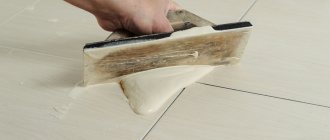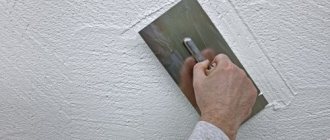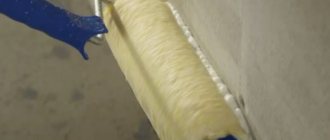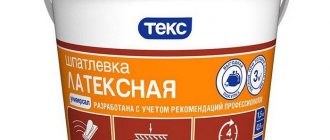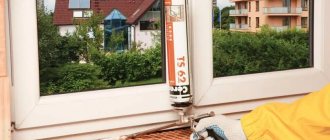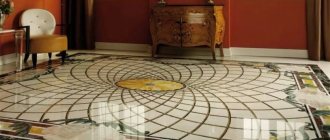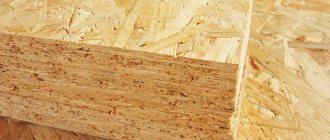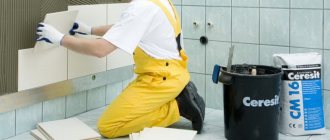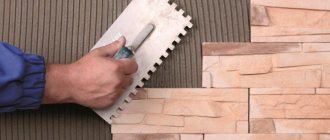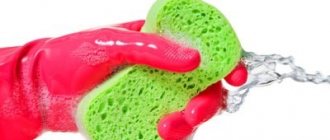Glue drying time table
I will give the drying time of tile adhesive using the example of popular cement-based compositions: from Ceresit and Unis.
| Glue name | Time to use the solution (in a bucket), hours | Working time (after application to surface), minutes | Tile adjustment time, minutes | Grouting joints, hours |
| Ceresit SM 9 | 2 | 10 | 15 | 48 |
| Ceresit SM 11 Plus | 2 | 15 | 20 | 24 |
| Ceresit SM 12 | 2 | 20 | 30 | 24 |
| Ceresit SM 14 Extra | 2 | 20 | 20 | 24 |
| Ceresit SM 16 Flex | 2 | 25 | 25 | 24 |
| Ceresit SM 17 | 2 | 30 | 30 | 24 |
| Ceresit SM 115 | 2 | 20 | 25 | 24 |
| Ceresit SM 117 | 2 | 20 | 15 | 24 |
| UNIS XXI | 3 | 10 | 10 | 24 |
| UNIS Hi Tech | 5 | 25 | 15 | 24 |
| UNIS Belfix | 3 | 15 | 15 | 24 |
| Eunice Pool | 3 | 10 | 10 | 24 |
| UNIS Plus | 3 | 20 | 10 | 24 |
| UNIS Granite | 3 | 15 | 10 | 24 |
| UNIS 2000 | 3 | 10 | 10 | 24 |
When adding elasticizers (for example, Ceresit SS 83), the time of using the solution is reduced by approximately 25%, but the open time and the time for adjusting the tiles increase. In this case, before grouting joints, it is better to wait twice the time recommended by the manufacturer.
During hardening, the glue shrinks noticeably. Therefore, the base should be smooth, the glue layer should be uniform and not thick. If you decide to correct large irregularities in the wall using a layer of glue, problems may arise: different ends of the tile will harden at different times, and it may come off or crack due to internal stress.
Do you want to see in practice how much the glue shrinks? Make a small groove in the wall and fill it with glue. Use a spatula to level the glue with the plane of the wall, and after drying, look at the resulting depression.
Fast drying glue
There is a quick-drying tile adhesive that has a reduced setting and hardening time:
| Name | Time to use the solution (in a bucket), hours | Working time (after application to surface), minutes | Tile adjustment time, minutes | Grouting joints, hours |
| IVSIL EXPRESS+ | 0,5 | 10 | 5 | 3 |
| Bolars Express Fast-hardening | 0,66 | 15 | 10 | 3 |
| KNAUF—Schnellkleber | 0,5 | 15 | 10 | 3 |
| Founds Scorplix T-15 | 0,5 | 10 | 10 | 3 |
When working with such a mixture, it is important to mix the glue in small portions and apply full load to the coating after at least 24 hours.
What is taken during the drying time of the adhesive composition?
Before deciding how long it takes for a tile to dry, it is important to understand the existing stages of hardening of the adhesive solution. In this case, there are 3 stages of glue hardening:
- installation condition (life period of the solution);
- primary setting (partial drying);
- final hardening.
Having understood this issue, you can clearly determine the amount of mixture to be mixed at one time and when you can walk on the tiles after laying.
Installation condition
After the master has diluted the mixtures in the required proportions, there is a limited period of time to work and adjust the position of the tiles. This takes into account such characteristics as:
- period of use after dilution;
- working hours after applying glue to the wall;
- adjustment period.
It is important to understand that the adhesive solution takes longer to dry in a bucket than on the surface. The solution can remain in the container for about 5 hours, and after laying on the wall it begins to set after 30 minutes. It takes no more than 15 minutes to adjust the tiles.
Primary setting
The primary hardening stage implies a period when the tile is in a static state and the mortar has already hardened. However, the tile still cannot withstand heavy loads. The drying time for tile adhesive on the floor is about a day. At this stage, you can start grouting and cleaning the tiles. At this stage, you can already walk on the tiles, but you need to do this carefully.
Final hardening
The third stage is final hardening. The coating reaches the required hardness only after a week and the tiles can be fully used: place heavy objects and expose them to the necessary impact. The drying period for tile adhesive may vary: some solutions take longer to harden, so it is necessary to study their composition.
How long does it take to dry on the floor?
The tiles on the floor are subject to serious loads, and there is always a danger of mechanical damage, so you cannot start using them immediately after installation.
Typically, tile adhesive takes a day to a week to dry completely. When the tiles are laid on a cement-sand screed, the required strength coefficient is achieved in 2-3 days.
If the conditions are ideal (humidity - 60%, t = +20 °C), then you can carefully walk on the tiles a day after laying, but even in this case, the seams are grouted only after 48 hours. To speed up hardening, you can turn on additional heating in the room .
Walking on the floor and rubbing the seams is prohibited until it has completely hardened for the following reasons:
- when the adhesive dries out, but does not have time to gain maximum strength, the possibility of the tile shifting remains;
- The tiles may become damaged or deformed, especially in areas where little adhesive was applied.
What parameters does polymerization depend on?
The glue hardens in several stages:
- Pot life of the adhesive mixture. This is the period during which the composition retains its adhesive properties. It should be sufficient to have time to open the bag at a normal pace, prepare the solution, apply it to the tile or base, and adjust the position (if necessary). The finished solution may not lose its characteristics for a long time, but when applied to the cladding material, it quickly loses moisture and becomes hard.
- Primary hardening. Changing the position of the tile at this stage is impossible, since it is already fixed and the composition has begun to harden, does not crack or spread. Fifteen hours after installing the tiles, the joints are grouted and the surface of the tile is cleaned of any adhesive residue.
- Final hardening. After complete polymerization, maximum strength of the composition is achieved. Dismantling the tiles will already be problematic. Average time is 1 week. However, if the tiles were laid on the floor, you are allowed to walk on them earlier, after 2 days.
The duration of work with the adhesive solution and the hardening period are influenced by several factors. Manufacturers, as a rule, indicate on the packaging the maximum polymerization period, taking into account that the humidity in the room will be approximately 60% and the air temperature will be between +20-25˚ C.
In practice, these indicators may vary, so you should take into account:
- air temperature in the room where the tiles are laid; if it is low, about +5-7˚ C, then primary hardening will take up to 4 days (for example, for the Ceresit 11 and Yunis 20 mixtures, which are used most often);
- a type of tile adhesive and additives included in its composition (can increase or decrease the hardening time);
- in a room with high humidity, the solution dries more slowly;
- the mixture hardens faster if applied to a flat base with high moisture absorption rates;
- the thicker the layer, the slower it hardens;
- the duration of final polymerization depends on how deep the seams between the tiles are when grouting;
- If the laid tiles are exposed to direct sunlight, the mixture will set faster.
Clay floor tiles dry faster than porcelain tiles. The drying time of the composition applied to a conventional screed is shorter than to a concrete screed. This is explained by the fact that concrete absorbs moisture contained in the adhesive solution less well.
Dependence of layer thickness on its hardening time
Another important factor that affects the hardening period of the adhesive mixture is the layer. If the layer is uneven, then the drying process is also uneven. Where the layer is smaller, the drying rate of the mixture is rapid; where it is larger, the hardening period increases.
The layer of tile adhesive should be oriented based on the manufacturer's recommendations. They are indicated on the packaging of the material.
When there is no time to wait for the solution to dry
There are mixture options that harden quickly and allow you to walk on the tiles - this is a quick-drying tile adhesive. Thanks to its unique composition, it is able to completely harden within three hours, after which grouting can begin immediately.
Fast drying adhesive tile adhesive
It is often used in combination with a branded self-leveling floor, thanks to which the fast-hardening tile adhesive IVSIL EXPRESS+ allows for complete installation, including all floor leveling work, in just one day.
Approximately these minimum deadlines must be observed. But we repeat that these are only manufacturers’ indicators, that is, the period for comfortable conditions, average temperature and humidity. Accordingly, if there is a deviation from the norm, drying may increase.
Stages of glue drying and work planning
The duration of finishing work largely depends on how long the glue takes to dry. This is relevant not only when laying tiles on the floor, but also on the wall. When you need to lay tiles over a large area and in the shortest possible time, you have to choose special types of glue. This, in turn, affects the duration of the intervals between the stages of finishing work.
You can determine the time during which tile adhesive dries by looking at its packaging. The manufacturer must indicate on it detailed instructions for using the mixture in different conditions. The drying period of the mixture most often directly depends on the temperature and humidity level in the room. But the drying speed also depends on the type of mixture and its composition.
All types of tile adhesive harden in several stages. The first stage lasts from the moment the package with the finished mixture is opened or the dry mixture is diluted. At this stage, the glue is completely usable. It is important to meet this period of time in order to carry out the entire process of laying and adjusting the position of the tiles before the glue begins to harden. While in the dilution container, the finished mixture can remain in a plastic state for quite a long time.
After applying a thin layer of the mixture to the surface, the process of moisture evaporation is activated, and the glue begins to dry. This phase can last several hours, during which the glue initially hardens. During this period of time, the laid tile will remain fixed in the appropriate position and it will no longer be possible to correct it.
What affects the rate of hardening?
When purchasing glue on the package, you can find an approximate curing time calculated based on “normal conditions”, that is, a temperature of 20-25 ° C, atmospheric pressure and air humidity not exceeding 60%. However, real repair conditions are almost always far from ideal, and, therefore, when calculating the real hardening time, the following indicators should be taken into account.
Let's take a closer look:
- The actual temperature of the room in which the tile laying work will be carried out. If the room temperature is low, then the period of primary hardening increases to four days.
- The composition of the glue depends on the manufacturing company and differs in components that change the drying speed.
- Waiting before use. When preparing an adhesive suspension, water must be added to dry glue in small portions. The amount of solution prepared should not be very large, so that you do not have to throw away the excess later. Before applying the wet adhesive mixture, it needs to rest for a few minutes so that the dry components and water combine more tightly. You can learn more from our review of how to properly dilute tile adhesive.
- The humidity of the room in which the work is carried out plays a major role during the drying period of the glue. Accordingly, the drier your room, the faster the adhesive solution will cure.
- Water absorption. The ability of the surface on which the glue is applied to quickly absorb moisture. It is necessary to choose materials that have the highest water absorption rate. This factor significantly speeds up the hardening process.
- The amount of adhesive composition (layer) also greatly influences the curing speed. Thicker layers require more time to dry.
- Seam width. You need to monitor the width and depth of the joints between the tiles and make it uniform throughout.
- Direct sunlight increases the drying rate of tile adhesive because it heats the surface it hits. On the street this is a natural factor.
How to speed up the process
You should not resort to radical measures to quickly dry the tile material in order to put the plane into operation. Rapid drying will lead to peeling of the tiles and the appearance of defects.
For more gentle acceleration, install a fan near the open door of the room. The power of the wind flow should be minimal.
To speed up the hardening process of the mortar layer, the “warm floor” system is not used. It will lead to cracking of the facing plane.
The main thing is that the drying process proceeds favorably and that the ventilation system is in good working order. If it does not work or is absent, then the door to the room should always be open.
How long does it take for tile grout to dry?
If you use a standard grout mixture, it will set within an hour after finishing work. Then you need to let the grout finally set; this will take another 3-4 hours; with the floor, things are more serious.
More time is needed here, because it is the floor tiles that will bear the main pressure . Much depends on the humidity in the room. During repairs it increases, keep this in mind.
River sand is rightfully the most popular building material due to its qualities and cost. It’s all about the different densities of river sand.
Recently, aerated concrete has become quite often used in house construction when constructing walls. Here we talk about the technology of applying plaster to aerated concrete.
Wall decoration is considered the main component for a truly cozy and beautiful interior of your room. By clicking on the link, you will learn how to decorate a room with stone using wall panels.
The mixture will finally harden after 10-15 days, but these periods specified by the manufacturer may vary depending on the room temperature and humidity level. If the grout contains epoxy resins, it will take longer to dry completely, up to 20 days.
Factors influencing curing time
Most often, any glue dries better in humidity conditions of no more than 60% and at an air temperature of +20...+25 °C.
To quickly complete the repair, it is better to choose quick-drying compounds, but only experienced tilers will be able to work with them efficiently. Typically, the following criteria influence the setting time.
Ambient humidity
High air humidity increases the drying time. And, conversely, when the air is dry, floor tiles dry faster. Thus, if the manufacturer indicates on the packaging the hardening time of its glue of 1-2 days, then when used in the bathroom and other rooms with increased dampness, the time can increase to 3-4 days.
Temperature
The adhesive sets faster in rooms with elevated air temperatures.
The optimal temperature range is +20…+22 °C. Depending on the brand of tile adhesive, the value may vary between +5...+30 °C. When the air cools below +5 °C, laying tiles is not recommended. It is better to wait for the temperature to rise or use additional heating.
Unnatural heating of the room is used as a last resort, since the quality of the coating suffers, the tiles become deformed or crack.
In summer, tiles stick faster than in winter, since the composition can not only harden, but freeze. This applies to non-frost-resistant mixtures.
Layer thickness
The hardening time of tile adhesive is directly proportional to the thickness of the adhesive layer. The larger it is, the longer it will take for the tile to set. If the mixture is applied unevenly, its drying time will differ in different areas of the surface.
To reduce the thickness of the layer, you can first level the base or apply the composition with a spatula with a smaller tooth height.
Material size
The number of tile joints affects the rate of moisture evaporation from the solution. When laying small tiles or mosaics, the total area of the seams is larger than when working with large tiles, so the glue will dry much faster in the first case.
The drying speed is also affected by the density of the facing material; for example, clay floor tiles will dry faster than porcelain stoneware.
Main surface material
On a surface with a high level of moisture absorption, the adhesive solution will dry much faster. The degree of absorption is determined by the porosity of the material. The more porous it is, the better the base absorbs liquid. In this case, the glue sets faster.
On a concrete screed, the glue takes longer to dry than when gluing tiles to a standard screed, since concrete does not absorb liquid from the solution well.
Brand and type of composition
- Standard adhesives. They freeze throughout the day. When t °C drops below +5 °C, the solution can dry out for at least 3 days.
- Reinforced. Dries faster. On average, complete contraction takes 12-24 hours. They are used for installation of large-sized cladding. Adheres well to concrete.
- Superglues. Their use speeds up repair work; after gluing the tiles, you can start grouting the joints within 4 hours. They adhere well to any surface and can be used in rooms with high dampness, and swimming pools. The main disadvantage is the high cost.
- Moisture resistant. Used in rooms with high dampness (steam rooms, swimming pools, bathrooms). An additional component is antiseptics that prevent the development of mold, mildew, and bacteria. They dry within a day.
- White. These are white cement-based adhesives for laying transparent tiles, glass blocks, and glass mosaics. They dry out within a day. After them there are no divorces left.
- Frost-resistant. Used in outdoor work. Tiles sit on them on facades, stairs, terraces. Withstands at least 10 freeze/thaw cycles. The average curing time is 36 hours.
Drying time on walls
As with the floor, the time for complete polymerization of the adhesive on the walls depends on the composition of the mixture, the type of tile and base, the size of the tile, as well as the conditions under which the material is applied and dried. Priming the walls accelerates polymerization. The minimum time for the glue to harden on the walls is two days.
An important factor is the evenness or curvature of the walls. If there are strong differences, the glue will harden unevenly. It is especially bad if this happens within the same tile: as a result, the fragment may crack. To avoid such problems, you should first level the walls and only then proceed with the installation of tiles.
Advice! As a means of leveling the surface of the wall, you can use plaster or the same mixture that will subsequently be used for laying tiles.
Curing speed depending on the adhesive
As mentioned earlier, the curing speed of the adhesive depends on various additives, the amount of which varies in adhesives from different manufacturers.
So the adhesive compositions are:
- Universal. These adhesive mixtures are used more often than others for laying small tiles. At a temperature of at least 20 ° C and a room humidity of no more than 70%, the curing time of such mixtures is on average 8-12 hours.
- Frost-resistant. Used for laying tiles on the outside of buildings (stairs, terraces, facades, etc.). These species are able to overcome many cycles of freezing and thawing during the cold season. The hardening time of such adhesives directly depends on weather conditions and is about 2 days.
- Reinforced. Such adhesive mixtures are intended for laying large tiles. Special additives that enhance adhesiveness allow the tiles to adhere well to the walls. We previously described such compositions in the article: Can tiles be glued to tiles? Their hardening takes no more than a day.
- Moisture resistant. These mixtures are specially designed for rooms with high humidity (baths, swimming pools, etc.). Curing time is also about 24 hours. It must be remembered that to prevent the formation of fungus in rooms with high humidity, the walls must be treated with antiseptics.
- White. Well suited for laying glass tiles and mosaics. They leave almost no streaks and harden in about a day.
How long does it take for tile adhesive to dry: when can you grout?
I want to complete the renovation as quickly as possible. But not all stages of work depend on the person. This is especially true for drying the adhesive solution on which the tiles are mounted. How long can tile adhesive dry? Several factors can influence this process.
What affects the drying speed of glue
- The thickness of the adhesive mixture applied. The thickness of the layer can be reduced or increased using the selected spatula. The larger the teeth, the thicker the adhesive mixture will be. Also, the screed must be perfectly level. Then the glue will be distributed in a thin layer.
- In the room, the air temperature should be kept stably at 24 degrees . The slightest fluctuations will prolong time of the glue. At sub-zero temperatures, you cannot install tiles with glue . The adhesive mixture will simply freeze, and in the spring the entire tile will fall off the base.
- Air humidity should not exceed 40%. The higher the humidity in the room, the longer it takes for the glue to dry.
- Screed temperature. In summer, the floor can also be cold, despite the fact that the air temperature is high. Therefore, it is necessary to take into account not only the air temperature, but also the degree of heating of the floor. The warmer the floor covering, the faster the tiles can be used.
- Floor moisture. If the screed was made several days ago, this is a clear contraindication for laying tiles. Before covering the floor with the adhesive mixture, you need to wait until the screed has dried thoroughly. This may take up to 2 weeks. The floor heating cannot be turned on. The tiles must dry gradually, otherwise the glue will crack and deteriorate. The service life of such coating will be significantly reduced.
- The size of the tile also has a significant impact on the drying time of the adhesive. When laying large tiles, there will be fewer seams in the room, which means that moisture from the adhesive will evaporate more slowly. Drying times will be maximum. A floor with small tiles will have more joints, so it will dry faster.
- The density of the floor covering has a direct impact on the drying time of the adhesive mixture. Tiles made from clay materials will dry faster than porcelain tiles. Clay has a lower density than tiles and is made from rocks .
- What the screed is made of has a significant impact on the drying time of the glue. A screed made of cement and sand absorbs moisture better, so the tiles will dry faster, and the adhesive base on a concrete screed will take longer to dry.
To make the tiles dry faster, the room can be heated. This will shorten the drying time. The floor heating cannot be turned on; the adhesive mixture will dry too quickly.
If you can create ideal conditions for laying tiles, then the finished floor can be used within a day . But achieving ideal conditions in real life is almost impossible.
How long will it take for floor tiles to dry after being laid with adhesive in non-ideal conditions?
This process can take from several days to a week. It is important to remember that you should not . If the adhesive mixture does not dry completely, walking on the tiles can damage or disrupt the installation itself.
Therefore, it is important to know how to check the readiness of the tiles for use.
Verification methods
- You can tap the corners of the tiles rubber hammer. This manipulation must be done as carefully as possible, otherwise the tile may burst or the adhesive layer may be damaged. If the tiles do not vibrate, it means that the glue has dried and the floor is ready for use.
Only a rubber hammer will do
- Grab the corners of the tile with both hands and try to lift it. If a corner of a tile comes off, it can easily be glued back on. To do this, be sure to choose tiles in the corner of the room, and not in the middle. There will be less noticeable deformation.
You need to use both checking methods to be sure that the tiles are well fixed. Qualified craftsmen must use these methods to ensure that the customer is satisfied with the work. And after time, there was no need to re-lay the tiles. To be sure that the glue has completely dried, it is better to start grouting the joints after laying the tiles no earlier than 5 days later.
If the glue dries too quickly, craftsmen do not advise you to be very happy. This is due to the rapid absorption of moisture from the adhesive mixture. To avoid this situation, experts recommend carefully priming the surface of the screed, especially if it has a porous structure.
When laying tiles, different types of adhesives are used. This fact is also of great importance when taking into account drying times. The characteristics of the types of adhesive mixture in each specific case will help answer the question of how long it takes for tile adhesive to dry. There is a wide variety of adhesives on the market for laying floor tiles. It is very difficult for a non-specialist to navigate the large assortment. Alternatively, you can hire a qualified technician. But, if this is not possible, then you need to read the characteristics.
Types of adhesive for laying tiles on the floor
- Universal. This adhesive mixture is used for installing lightweight tiles. The minimum drying time is about 8 hours, and the maximum is a little more than a day. is not suitable for laying porcelain tiles .
- Special mixture for heavy tiles. The drying time will vary from a day, in ideal conditions, to several, especially in high humidity.
- Frost-resistant mixture. If styling is required urgently, and it’s frosty outside. In this case, frost-resistant glue is used. It dries in at least three days, but this process can last up to 1 week.
- Moisture resistant glue. When laying tiles indoors with high humidity or outdoors, experts give preference to a moisture-resistant mixture. The hardening time ranges from a day to several days.
- Adhesive for glass tiles. It is not very common, but it is still used. Drying time - from a day to several days.
There are situations when there is no time to wait for the adhesive mixture to completely harden. Then use a quick-drying mixture.
How long will it take for tile adhesive to dry on the floor?
This adhesive mixture will dry in three hours under literally any conditions. It is often used with a mixture of the same composition for the poured floor. In tandem they will dry as quickly as possible.
Stages of glue drying.
- The first stage is to apply the mixture to the floor and lay the tiles themselves. Some types of glue can allow you to do these manipulations within an hour, and for some the period of non-hardening lasts up to several hours.
- Initial hardening stage. It is characterized by the fact that the tiles no longer move; you can carefully begin grouting the joints, but loading them for several days is contraindicated. Furniture can be placed after 4 days .
- Complete stage . This period begins 7 days after the tiles are laid. The floor can be used: walking, arranging furniture, carrying strollers.
Many people are interested in: how long does it take for glue to dry on the floor? Everyone is in a hurry to put the flooring into operation. You need to remember the main rule of good installation of floor tiles. High-quality drying of the adhesive element is the key to long service life of the coating.
If circumstances arise that you have to walk on a half-dry floor, then you need to put wooden boards or a sheet of plywood on the floor. This method will help reduce the load on the floor covering and prevent damage or displacement of the tiles.
Precautions when walking on dry tiles.
- Shoes should be soft, with smooth soles.
- There should be no heels on the soles.
- Nothing should fall on the tile.
- Do not place heavy or sharp objects.
It has already become clear how long it takes for the glue to dry. It's time to move on to dismantling the plastic crosses from the seams.
Removing plastic crosses from seams
to pull them out . If they are installed to a depth of more than 2 mm, then they do not need . At this depth they will not interfere with grouting. It is recommended to remove the crosses when the glue dries well. The tile should not move when the clamp is pulled out. The next day, grouting can be done.
How long does it take for tile adhesive to dry? This is the most frequently asked question for everyone who is faced with laying tiles. Even professionals will not be able to give an accurate answer. The only correct solution is to read the manufacturer's instructions. But you need to remember that the average drying times under almost ideal conditions are indicated there. In reality, you need to add several days to the specified time frame. Then the experience of installing floor tiles will be positive.
Let's sum it up
Even qualified tilers are not able to accurately determine the required time for the tile adhesive to completely harden. There are so many experts, so many opinions, so the answers to the question of how long tile adhesive should dry will be different. Deadlines will be determined based on the specific case.
When drawing a conclusion, it is necessary to pay attention to many factors that affect the drying time of the glue. Therefore, it is recommended to carefully read the composition of the mixture and the drying time specified by the manufacturer. When purchasing quick-drying solutions, pay attention to the minimum application time after mixing.
The choice of composition largely depends on the specific room where it is planned to lay floor and wall tiles. If you do not have the skills for this process, then it is better to use professional services to avoid wasting your time and money.
